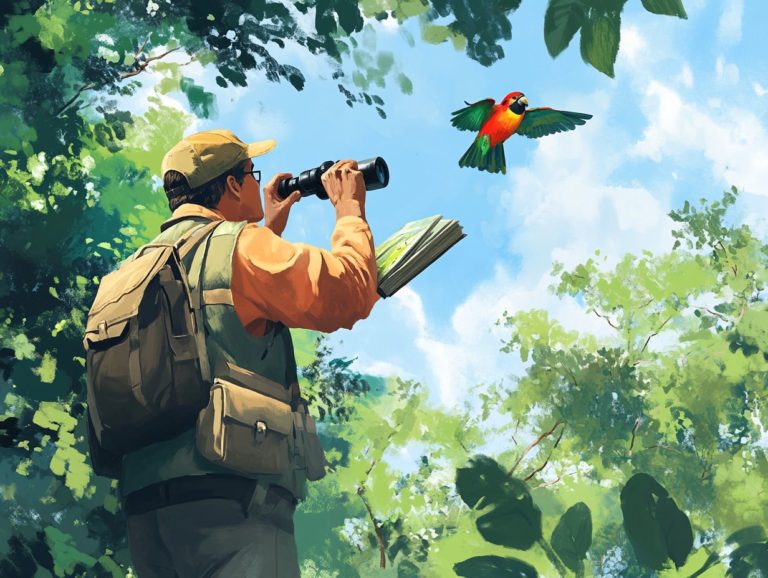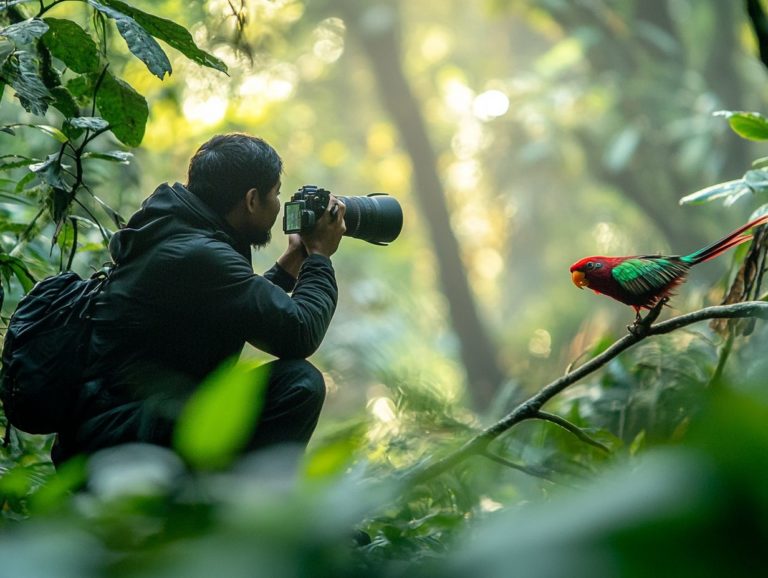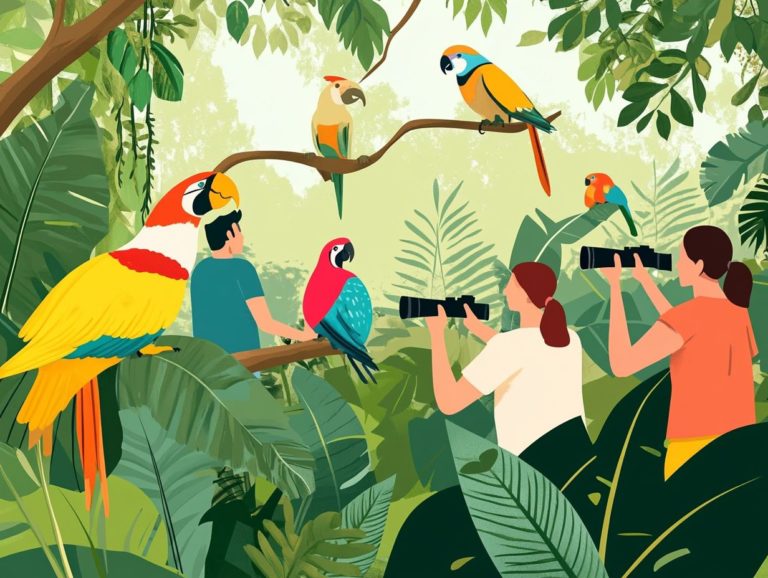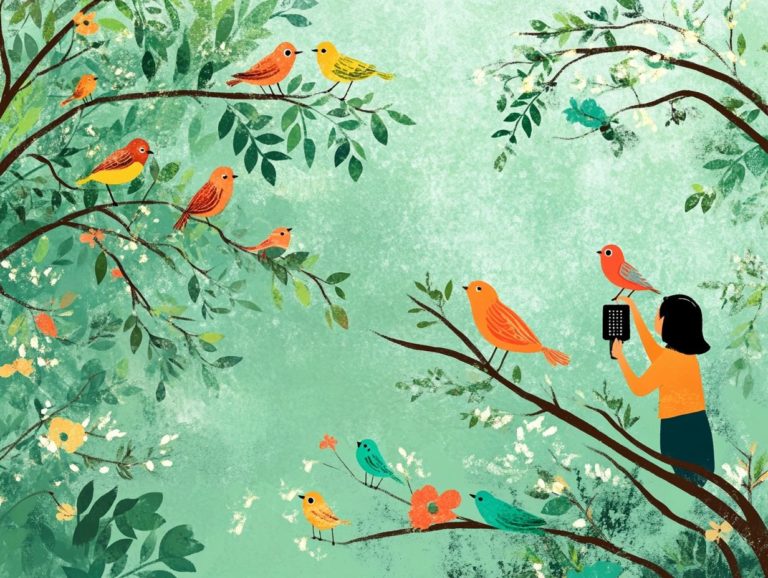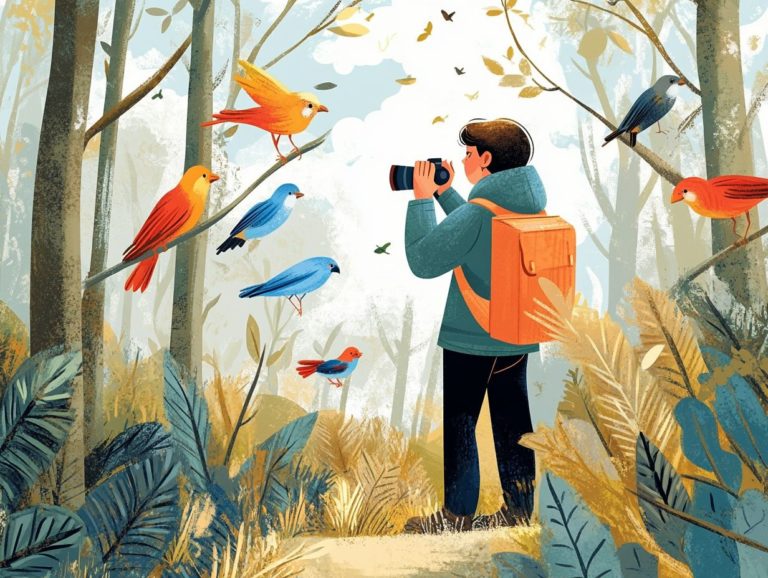How Do I Balance Bird Watching with Nature Conservation?
Bird watching is a delightful hobby. It helps us understand and appreciate the relationships within our ecosystems, including the importance of nature walks to explore these habitats.
As enthusiasts explore nature, it is essential to consider the impact of their passion on the environment. This includes using binoculars and field guides to enhance their bird identification skills. Let’s explore how to enjoy bird watching while protecting our precious environments!
You will discover essential practices today to help protect our birds, ways to support conservation efforts, and the role technology plays in fostering a sustainable relationship with nature. This includes using apps for bird identification. Join us on this journey to harmonize your love for birds with a commitment to their preservation, while also exploring the wellness benefits of bird watching.
Contents
- Key Takeaways:
- The Importance of Nature Conservation in Bird Watching
- Tips for Balancing Bird Watching and Conservation
- Collaborating with Conservation Organizations
- The Role of Technology in Bird Watching and Conservation
- Frequently Asked Questions
- How do I balance bird watching with nature conservation?
- Why is it important to balance bird watching with nature conservation?
- What are some ways I can balance bird watching with nature conservation?
- How can I minimize my impact as a bird watcher?
- Should I participate in citizen science projects as a bird watcher?
- What is the most important thing to remember when balancing bird watching with nature conservation?
Key Takeaways:
- Take a responsible approach to bird watching by understanding the impact of your actions on the environment. This includes minimizing disturbances to urban birding areas.
- Support conservation efforts by following ethical guidelines. Actively support organizations that work towards preserving bird habitats, such as local environmental groups.
- Use technology for sustainable bird watching and conservation efforts. This includes using birding apps, participating in citizen science projects, and engaging in educational events.
The Importance of Nature Conservation in Bird Watching
The significance of nature conservation in bird watching lies in its ability to deepen our understanding of ecosystems and strengthen the relationship between humans and wildlife. By observing birds in their natural habitats, bird watchers gain valuable insights into their local environments.
This engagement fosters a sense of mindfulness and respect for nature, creating a sense of responsibility toward conservation efforts. It ensures that a diverse range of bird species and their habitats will thrive for future generations. Bird watching builds a strong community that actively participates in educational events and natural bird counts, both of which are essential to successful conservation projects.
Understanding the Impact of Bird Watching on the Environment
Bird watching positively impacts the environment by enhancing knowledge of ecosystems and highlighting how wildlife depends on each other through the appreciation of bird songs. When individuals engage in bird watching, they tend to observe more local species in their natural habitats.
This fosters a greater awareness of local biodiversity and the vital roles different birds play within the ecosystem. It can also elevate awareness of broader environmental issues, such as habitat destruction and climate change.
Citizen science programs like the Audubon Society’s bird count encourage participants to document and report bird populations. This information contributes to a larger dataset that is crucial for conservation efforts.
Furthermore, individuals who partake in bird watching often report increased mindfulness. The anticipation of quietly waiting for a glimpse of a rare bird fosters a meditative connection with nature, enhancing both mental health and environmental awareness.
Tips for Balancing Bird Watching and Conservation
Responsible bird watching and conservation involve enjoying nature mindfully while actively protecting it.
Responsible Bird Watching Practices
Responsible bird watching practices are essential for protecting birds’ habitats and well-being. They also enhance the enjoyment of the activity itself. It’s important to use binoculars appropriately to minimize disturbance and ensure that observers do not encroach upon nesting and resting areas while watching birds.
By adhering to established guidelines, such as observing birds during times that do not cause undue stress, bird watchers contribute to a healthier environment. These practices not only enhance the bird-watching experience but also foster a stronger connection to conservation efforts.
When bird watchers follow these responsible practices, they help ensure that bird populations will thrive for future generations.
Supporting Conservation Efforts
Bird watchers can significantly contribute to conservation efforts, positively impacting both the environment and the birding community. By actively participating in these initiatives, they can enhance protecting bird homes and protect bird species.
One effective way to assist conservation is by engaging in annual bird counts, which track population trends and provide essential data for informed conservation decisions. Collaborating with local environmental groups amplifies their efforts and connects them with others who share a passion for nature and wildlife.
Join engaging educational events to boost your skills and knowledge, allowing you to advocate for conservation within your community. These actions strengthen conservation efforts and foster a community dedicated to preserving the natural world.
Collaborating with Conservation Organizations
Partnering with conservation organizations enables bird watchers to enhance their impact on wildlife and habitat conservation.
How to Get Involved and Make a Difference
Bird watchers can actively participate in conservation efforts by engaging with their communities. They can volunteer at local wildlife rehabilitation centers, donate to organizations that support birds, and join local initiatives encouraging sustainable practices.
These community-driven initiatives enhance understanding of local ecosystems inhabited by birds and teach how to care for these environments. Such initiatives also connect participants with like-minded individuals passionate about environmental conservation and educate others on the importance of preserving bird habitats.
Advocating for the protection of birds and their habitats through social media campaigns, local government meetings, and public forums offers a broader platform to share stories and experiences. Participating in educational programs designed to teach sustainable practices highlights the importance of community engagement in preserving local ecosystems for future generations.
The Role of Technology in Bird Watching and Conservation
Technology plays an increasingly important role in bird watching and conservation, offering tools that enhance the experience and effectiveness of both activities.
Using Technology for Sustainable Bird Watching
Technology for sustainable bird watching enhances the experience and improves the ability to accurately identify different bird species. A wide range of applications for bird identification transforms outdoor pursuits into a more interactive and educational experience.
These applications feature databases containing thousands of species, high-resolution images, vocalizations, and key distinguishing characteristics that assist in identifying local flora and fauna. Advanced binoculars equipped with smart features, such as image stabilization and GPS tracking, facilitate better observation of birds and tracking of migratory patterns.
Utilizing these tools during excursions allows observers to expand their knowledge of birdlife and contribute to sustainable bird watching practices that minimize disturbances to both birds and their habitats.
Conservation Efforts Utilizing Technology
Conservation efforts increasingly utilize technology to enhance environmental knowledge and promote community engagement. By incorporating innovative tools such as tracking apps to monitor wildlife populations and data collection platforms for gathering vital information on biodiversity, these initiatives significantly protect natural habitats.
Digital campaigns play a crucial role in raising awareness and encouraging participation among local communities, enabling individuals to contribute to conservation goals. Social media has emerged as a powerful catalyst for dialogue, inspiring collective action and creating networks that connect volunteers, researchers, and advocates.
Through these technologies, the synergy between scientific research and community involvement drives impactful solutions and fosters a deeper appreciation for the environment.
Frequently Asked Questions
Get involved today and make a difference for our feathered friends!
How do I balance bird watching with nature conservation?
Bird watching and nature conservation can go hand in hand, especially through observing birds in their natural environments. By following some simple guidelines, you can enjoy your hobby while protecting the environment and the birds you love.
Why is it important to balance bird watching with nature conservation?
Nature conservation is essential for the long-term survival of bird species and their habitats. Being mindful of your impact as a bird watcher helps preserve these areas and protect the birds, their habitats, and the overall health of local ecosystems for future generations.
What are some ways I can balance bird watching with nature conservation?
Some ways to balance bird watching with nature conservation include staying on designated trails, avoiding disturbing nesting areas, and not feeding wild birds. It’s also important to properly dispose of trash and respect the peace and quiet of the natural environment.
How can I minimize my impact as a bird watcher?
Make it a priority to learn about local laws and regulations regarding bird watching and conservation. Using binoculars and telephoto lenses instead of getting too close to birds helps reduce disturbance to their natural behaviors. Familiarizing yourself with field guides and using apps can enhance your understanding of the variety of environments where birds live and bird species.
Should I participate in citizen science projects as a bird watcher?
Yes! Participating in citizen science projects, such as bird counts and monitoring programs, is a great way to contribute to nature conservation efforts. These projects provide valuable data for researchers and conservationists to understand and protect bird populations. Join a local project today and make a real difference!
What is the most important thing to remember when balancing bird watching with nature conservation?
The most important thing to remember is to always prioritize the well-being of the birds and their habitats. Being responsible and respectful allows you to enjoy bird watching while contributing to the conservation of these beautiful creatures. Taking time to appreciate bird songs and understanding migration patterns can enhance your experience, benefiting both your mental health and your connection to wildlife.

